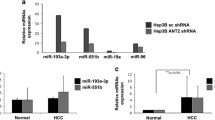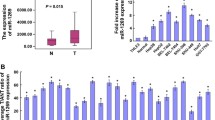Abstract
MicroRNAs are small non-coding RNAs that regulate the expression of other genes in a post-transcriptional manner. MiR-34a can induce apoptosis, cell cycle arrest, and senescence. However, its role in tumor progress remains to be fully elucidated. In the present study, the role of miR-34a in lymphatic metastasis was investigated using mouse hepatocarcinoma cell lines Hca-F and Hepa1-6. MicroRNA profiling and Hairpin-RT-PCR analysis showed that the expression level of miR-34a was higher in Hepa1-6 cells (of no metastatic ability) than that in Hca-F cells (of high metastatic ability). Ectopic expression of miR-34a can inhibit cell growth and cell invasion in Hepa1-6 and Hca-F cells. Moreover, miR-34a triggers G1 arrest and down-regulates CyclinD1 and CDK6 in Hepa1-6 cells. Furthermore, we proved that miR-34a decreased adhesion of Hca-F cells to regional lymph node in vitro, reduced lymph nodes-metastasized burden, and inhibited tumor lymph node metastases in vivo. All these results suggest that miR-34a plays multiple tumor suppressive roles in murine hepatocarcinoma, not only inhibiting cell growth by cell cycle arrest, but also repressing metastasis, and may serve as a novel therapeutic target for hepatocarcinoma.






Similar content being viewed by others
References
Achen MG, McColl BK, Stacker SA (2005) Focus on lymphangiogenesis in tumor metastasis. Cancer Cell 7:121–127
Minsky BD, Mies C, Rich TA, Recht A (1989) Lymphatic vessel invasion is an independent prognostic factor for survival in colorectal cancer. Int J Radiat Oncol Biol Phys 17:311–318
Foster RS Jr (1996) The biologic and clinical significance of lymphatic metastases in breast cancer. Surg Oncol Clin N Am 5:79–104
Fidler IJ (1990) Critical factors in the biology of human cancer metastasis: twenty-eighth G.H.A. Clowes memorial award lecture. Cancer Res 50:6130–6138
Poste G, Fidler IJ (1980) The pathogenesis of cancer metastasis. Nature 283:139–146
Filipowicz W, Bhattacharyya SN, Sonenberg N (2008) Mechanisms of post-transcriptional regulation by microRNAs: are the answers in sight? Nat Rev Genet 9:102–114
Medina PP, Slack FJ (2008) microRNAs and cancer: an overview. Cell Cycle 7:2485–2492
He L, He X, Lim LP, de Stanchina E, Xuan Z, Liang Y, Xue W, Zender L, Magnus J, Ridzon D, Jackson AL, Linsley PS, Chen C, Lowe SW, Cleary MA, Hannon GJ (2007) A microRNA component of the p53 tumour suppressor network. Nature 447:1130–1134
Bommer GT, Gerin I, Feng Y, Kaczorowski AJ, Kuick R, Love RE, Zhai Y, Giordano TJ, Qin ZS, Moore BB, MacDougald OA, Cho KR, Fearon ER (2007) p53-mediated activation of miRNA34 candidate tumor-suppressor genes. Curr Biol 17:1298–1307
Chang TC, Wentzel EA, Kent OA, Ramachandran K, Mullendore M, Lee KH, Feldmann G, Yamakuchi M, Ferlito M, Lowenstein CJ, Arking DE, Beer MA, Maitra A, Mendell JT (2007) Transactivation of miR-34a by p53 broadly influences gene expression and promotes apoptosis. Mol Cell 26:745–752
Corney DC, Flesken-Nikitin A, Godwin AK, Wang W, Nikitin AY (2007) MicroRNA-34b and MicroRNA-34c are targets of p53 and cooperate in control of cell proliferation and adhesion-independent growth. Cancer Res 67:8433–8438
Tazawa H, Tsuchiya N, Izumiya M, Nakagama H (2007) Tumor-suppressive miR-34a induces senescence-like growth arrest through modulation of the E2F pathway in human colon cancer cells. Proc Natl Acad Sci USA 104:15472–15477
Tarasov V, Jung P, Verdoodt B, Lodygin D, Epanchintsev A, Menssen A, Meister G, Hermeking H (2007) Differential regulation of microRNAs by p53 revealed by massively parallel sequencing: miR-34a is a p53 target that induces apoptosis and G1-arrest. Cell Cycle 6:1586–1593
Raver-Shapira N, Marciano E, Meiri E, Spector Y, Rosenfeld N, Moskovits N, Bentwich Z, Oren M (2007) Transcriptional activation of miR-34a contributes to p53-mediated apoptosis. Mol Cell 26:731–743
Lewis BP, Burge CB, Bartel DP (2005) Conserved seed pairing, often flanked by adenosines, indicates that thousands of human genes are microRNA targets. Cell 120:15–20
Sun F, Fu H, Liu Q, Tie Y, Zhu J, Xing R, Sun Z, Zheng X (2008) Downregulation of CCND1 and CDK6 by miR-34a induces cell cycle arrest. FEBS Lett 582:1564–1568
Wei JS, Song YK, Durinck S, Chen QR, Cheuk AT, Tsang P, Zhang Q, Thiele CJ, Slack A, Shohet J, Khan J (2008) The MYCN oncogene is a direct target of miR-34a. Oncogene 27:5204–5213
Yamakuchi M, Ferlito M, Lowenstein CJ (2008) MiR-34a repression of SIRT1 regulates apoptosis. Proc Natl Acad Sci USA 105:13421–13426
Zhou H, Jia L, Wang S, Wang H, Chu H, Hu Y, Cao J, Zhang J (2006) Divergent expression and roles for caveolin-1 in mouse hepatocarcinoma cell lines with varying invasive ability. Biochem Biophys Res Commun 345:486–494
Jia L, Cao J, Wei W, Wang S, Zuo Y, Zhang J (2007) CD147 depletion down-regulates matrix metalloproteinase-11, vascular endothelial growth factor-A expression and the lymphatic metastasis potential of murine hepatocarcinoma Hca-F cells. Int J Biochem Cell Biol 39:2135–2142
Calin GA, Sevignani C, Dumitru CD, Hyslop T, Noch E, Yendamuri S, Shimizu M, Rattan S, Bullrich F, Negrini M, Croce CM (2004) Human microRNA genes are frequently located at fragile sites and genomic regions involved in cancers. Proc Natl Acad Sci USA 101:2999–3004
Chen HC, Chen GH, Chen YH, Liao WL, Liu CY, Chang KP, Chang YS, Chen SJ (2009) MicroRNA deregulation and pathway alterations in nasopharyngeal carcinoma. Br J Cancer 100:1002–1011
Deng S, Calin GA, Croce CM, Coukos G, Zhang L (2008) Mechanisms of microRNA deregulation in human cancer. Cell Cycle 7:2643–2646
Inamura K, Togashi Y, Nomura K, Ninomiya H, Hiramatsu M, Satoh Y, Okumura S, Nakagawa K, Ishikawa Y (2007) Let-7 microRNA expression is reduced in bronchioloalveolar carcinoma, a non-invasive carcinoma, and is not correlated with prognosis. Lung Cancer 58:392–396
Calin GA, Cimmino A, Fabbri M, Ferracin M, Wojcik SE, Shimizu M, Taccioli C, Zanesi N, Garzon R, Aqeilan RI, Alder H, Volinia S, Rassenti L, Liu X, Liu CG, Kipps TJ, Negrini M, Croce CM (2008) MiR-15a and miR-16–1 cluster functions in human leukemia. Proc Natl Acad Sci USA 105:5166–5171
Welch C, Chen Y, Stallings RL (2007) MicroRNA-34a functions as a potential tumor suppressor by inducing apoptosis in neuroblastoma cells. Oncogene 26:5017–5022
Li N, Fu H, Tie Y, Hu Z, Kong W, Wu Y, Zheng X (2009) MiR-34a inhibits migration and invasion by down-regulation of c-Met expression in human hepatocellular carcinoma cells. Cancer Lett 275:44–53
Fujita Y, Kojima K, Hamada N, Ohhashi R, Akao Y, Nozawa Y, Deguchi T, Ito M (2008) Effects of miR-34a on cell growth and chemoresistance in prostate cancer PC3 cells. Biochem Biophys Res Commun 377:114–119
Bloom J, Cross FR (2007) Multiple levels of cyclin specificity in cell-cycle control. Nat Rev Mol Cell Biol 8:149–160
Gutierrez C, Ramirez-Parra E, Castellano MM, del Pozo JC (2002) G (1) to S transition: more than a cell cycle engine switch. Curr Opin Plant Biol 5:480–486
Vermeulen K, Van Bockstaele DR, Berneman ZN (2003) The cell cycle: a review of regulation, deregulation and therapeutic targets in cancer. Cell Prolif 36:131–149
Hermeking H (2007) p53 enters the microRNA world. Cancer Cell 12:414–418
Cheung ST, Chen X, Guan XY, Wong SY, Tai LS, Ng IO, So S, Fan ST (2002) Identify metastasis-associated genes in hepatocellular carcinoma through clonality delineation for multinodular tumor. Cancer Res 62:4711–4721
Acknowledgments
This study was supported by Grants from the National Natural Science Foundation of China (No. 30970648) and the Research Fund for the Doctoral Program of Higher Education (No. 20092105110002).
Author information
Authors and Affiliations
Corresponding author
Rights and permissions
About this article
Cite this article
Guo, Y., Li, S., Qu, J. et al. MiR-34a inhibits lymphatic metastasis potential of mouse hepatoma cells. Mol Cell Biochem 354, 275–282 (2011). https://doi.org/10.1007/s11010-011-0827-0
Received:
Accepted:
Published:
Issue Date:
DOI: https://doi.org/10.1007/s11010-011-0827-0




